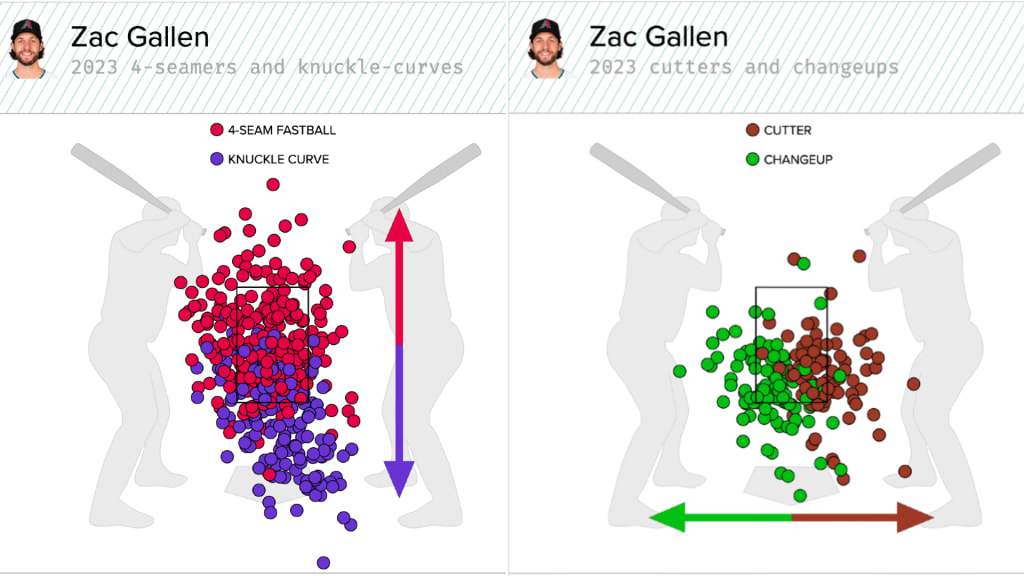Another year, another scoreless streak for Zac Gallen. Here's how he's doing it this time.
Last season, when the D-backs' ace pitched 44 1/3 scoreless innings in a row, we broke down three key stats behind his lights-out run.
It's time for the second edition. Gallen's streak of 28 straight scoreless innings was snapped when he allowed a first-inning run to the Rangers on Tuesday, but let's take a look at what's making him so effective this season.
Here are three new reasons that explain why teams can't score on Gallen in 2023.
1) He controls the zone in every direction
Here's something Vinnie Pasquantino said about Gallen after his last start: "He uses the same pitches, both sides -- and by same pitches, I mean, he’ll use a cutter, he’ll go to a changeup off that, he’ll go to a four-seam off that, and then he’ll use the big curveball off that."
With those pitch combinations, Gallen controls the entire strike zone.
One of his four pitches controls each area a hitter has to cover: Gallen's four-seam fastball controls the top of the zone, his knuckle-curve controls the bottom of the zone, his cutter controls the right side of the zone and his changeup controls the left side of the zone.

Let's split his four-pitch mix into two pairings, along the lines of what Pasquantino said: cutter/changeup and fastball/curveball. Gallen attacks hitters up and down with his four-seamer and knuckle-curve, and he goes side to side with his cutter and changeup.
Gallen's four-seam fastball has a lot of carry. Even though he sits only around 94 mph, his fastball gets about two inches more "rise" than an average four-seamer. Meanwhile, his 83 mph knuckle-curve is generating three inches more drop than an average curveball. They're his weapons to pitch vertically.
Gallen's cutter and changeup, on the other hand, are for pitching horizontally. They come in at almost the same velocity (88 mph for the cutter, 86 mph for the changeup) and drop basically the same amount. But they break in opposite directions across the zone -- the cutter cuts five inches to his glove side, and the changeup fades 13 inches to his arm side -- and Gallen throws them to opposite sides of the plate.
2) He's dominating the edges again
Not only can Gallen go north, south, east and west, he can do it with pinpoint command.
Gallen's control of the edges of the strike zone was behind his breakout as a young ace, and he's doing it again in 2023. He's been one of the top pitchers in baseball at preventing runs by pitching to the edges.
By Statcast's run value metric, Gallen is tied for seventh-best in MLB this season with nine runs prevented on the edges.
In particular this season, his cutter and changeup have been precisely located. Look at the heatmaps of where he's throwing those two pitches in 2023. He's just spotting them up on the corners.
3) He's leaning into his secondary stuff
Gallen's fastball has always gotten great results, and he's never been afraid to throw it to try to get a K, but it also doesn't force as many whiffs as his other pitches. This season, he's embracing the swing-and-miss potential of his secondaries.
He's throwing fewer fastballs overall, and his other offerings are accounting for a higher share of his strikeout total. Gallen has 14 strikeouts on four-seamers and 35 on his other pitches (18 on knuckle-curves, 10 on changeups and seven on cutters). Last season, he had 88 on four-seamers and 104 on his other pitches. The percentage of Gallen's K's coming on secondary pitches has increased from 54% to 71%.
Gallen is generating significantly higher swing-and-miss rates with his secondary pitches this season compared to last. Here's why each of them has been so effective.
• Knuckle-curve (34% to 46% whiff rate)
Once he gets ahead of a hitter, Gallen buries his curveball below the zone. Look at where he's throwing his knuckle-curve in pitchers' counts.
Hitters have a hard time laying off and an even harder time connecting. They chase against Gallen 33% of the time, and they make contact on just 44% of those chase swings.
• Changeup (25% to 41% whiff rate)
Gallen's changeup lives on the bottom of the zone. He keeps it on the edges well over half the time, one of the highest rates by any pitcher with a single pitch type.
Highest edge % with individual pitch, 2023
Chris Sale's changeup: 60%
Brusdar Graterol's sinker: 60%
Marco Gonzales' changeup: 58%
Tanner Houck's cutter: 57%
Zac Gallen's changeup: 57%
• Cutter (16% to 29% whiff rate)
Gallen has changed speeds more with his cutter this season, at times taking off some velocity, which gives it more room to move.
2022 cutter: 90 mph, 27" of drop, 5" of break
2023 cutter: 88 mph, 31" of drop, 5" of break
If he throws it harder, it has tighter break and looks more like his fastball. When he throws it slower, he creates more velocity differential from his four-seamer, so the cutter can function like more of a breaking pitch that mirrors his changeup.
When you can command the entire zone, and live on the edges while you do it and beat hitters with all your pitches, you get the elite strikeout-to-walk numbers Gallen is posting this season.
Gallen is striking out over 36% of the batters he faces while walking under 4%. His 10.2 strikeout-to-walk ratio is third-best in the Majors behind George Kirby and Jacob deGrom, and his 32.6-point K-BB% is third-best behind deGrom and Spencer Strider.
And you also get the string of zeros he's putting up. Gallen might not overpower you, but he outpitches you, inning after scoreless inning.
David Adler is a reporter for MLB.com based in New York.




